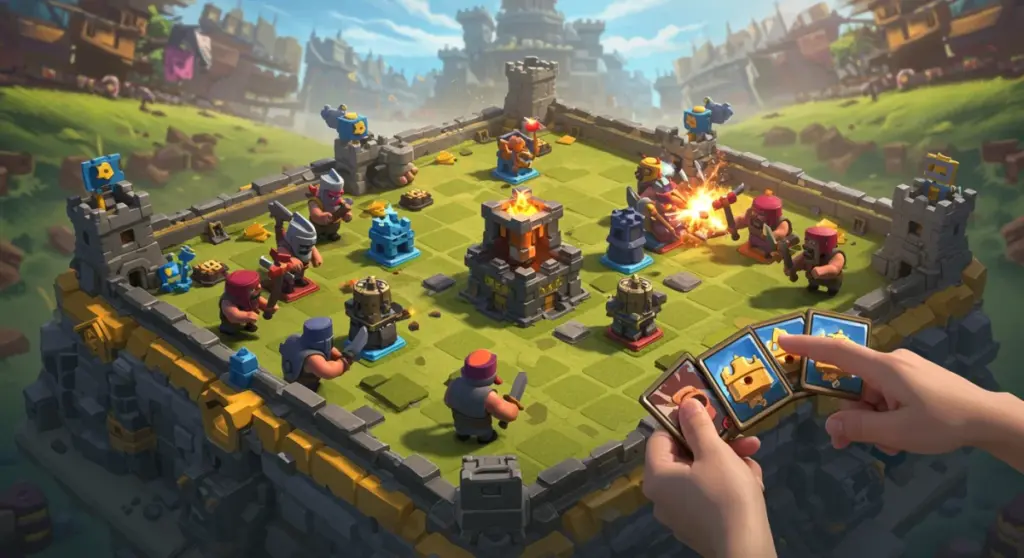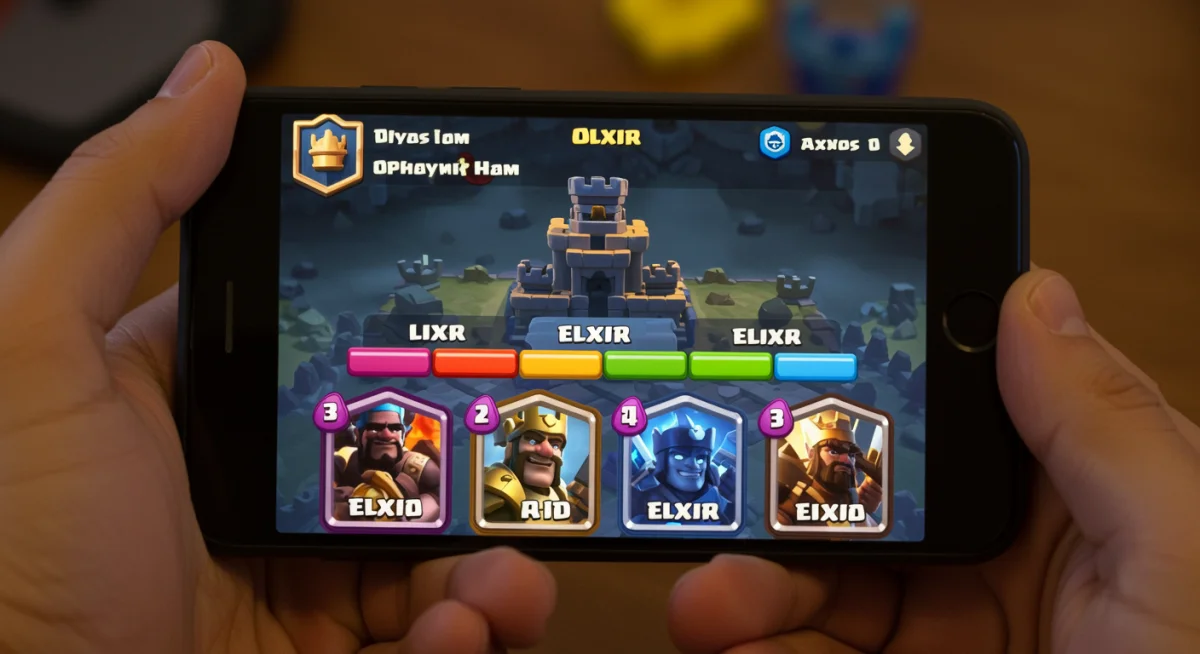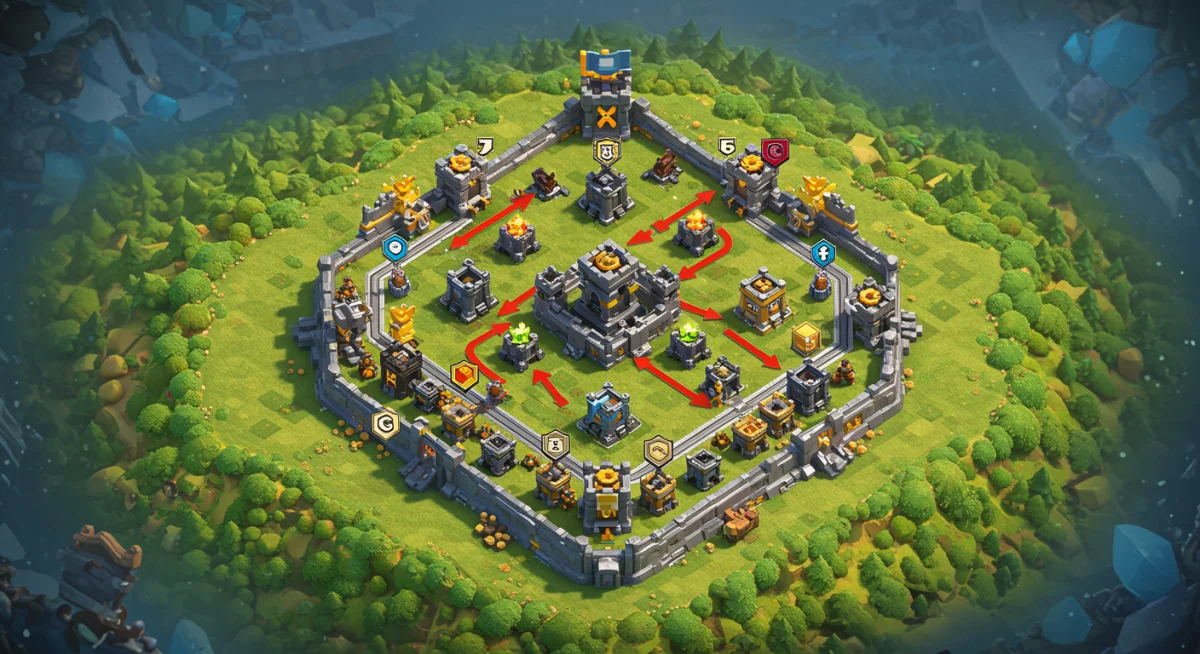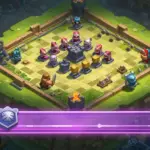Clash Royale: Avoid These 5 Common Mistakes to Climb Faster

Anúncios
To improve your Clash Royale performance, actively avoid common pitfalls like poor elixir management, ineffective deck synergy, and reactive gameplay, which are crucial for consistent ladder climbing.
Are you struggling to climb the ranks in Clash Royale? Do you find yourself stuck in a loop of victories and defeats, unable to break through to the next arena? It’s a common experience, but often, the solution lies not in acquiring legendary cards, but in recognizing and rectifying fundamental errors. This guide will help you to avoid these 5 common Clash Royale mistakes: improve your gameplay and climb the ladder faster, transforming your approach to every battle and making your climb more consistent and enjoyable.
Mismanaging Elixir: The Foundation of Failure
Elixir is the lifeblood of Clash Royale; without it, your cards are just pretty pictures. Many players, especially those new to the game or stuck in lower arenas, make the critical mistake of mismanaging this precious resource. This often manifests as either over-committing to an attack or passively holding onto a full elixir bar, both of which can lead to significant disadvantages.
Understanding elixir management is paramount. It dictates your ability to respond to threats, mount effective offenses, and maintain control of the arena. A common error is playing cards as soon as you have enough elixir, without considering the opponent’s current hand or your defensive needs. This reactive, rather than proactive, deployment can leave you vulnerable to counter-attacks.
Over-committing to Offense
One of the most tempting traps in Clash Royale is to go all-in on an attack, emptying your elixir bar in a desperate attempt to take down a tower. While aggressive plays can sometimes work, they often leave you completely exposed to your opponent’s counter-push. Imagine deploying a Golem, Witch, and Mega Knight all at once on one lane. If your opponent has an effective defense, not only will your push be stopped, but you’ll have no elixir left to defend their subsequent attack on the other lane.
- Avoid deploying multiple high-cost cards simultaneously without a clear plan for defense.
- Always keep enough elixir in reserve to respond to unexpected threats.
- Analyze your opponent’s defensive patterns before committing to a large push.
Elixir Leaking: A Silent Killer
On the flip side, many players ‘leak’ elixir by letting their elixir bar hit ten and stay there for extended periods. This is essentially wasting elixir that could have been used to cycle through cards, build up a defensive position, or apply pressure. Every drop of elixir that goes unused when your bar is full is a missed opportunity, potentially giving your opponent a significant advantage over the course of a match.
Effective elixir management involves constantly being aware of your elixir bar and making sure it’s always regenerating, ideally without hitting full unless you’re intentionally saving for a big play. This doesn’t mean playing cards haphazardly; it means understanding when to play a cheap card to cycle your deck, when to place a defensive troop, or when to prepare for a counter-push. It’s a delicate balance that requires practice and keen observation of the game’s flow.
Mastering elixir management will fundamentally change how you play Clash Royale. It allows for more fluid transitions between offense and defense, provides flexibility in response to your opponent’s moves, and ultimately leads to more consistent victories. Pay close attention to your elixir bar and your opponent’s, and you’ll immediately see an improvement in your game.
Ignoring Deck Synergy: More Than Just Powerful Cards
Many players fall into the trap of simply throwing together their favorite or highest-level cards, assuming that raw power will guarantee victory. However, Clash Royale is a game of intricate interactions, and a deck’s true strength lies in its synergy – how well the cards work together to achieve a common goal. Ignoring deck synergy is a significant mistake that can stunt your progress, even with a collection of powerful individual cards.
A synergistic deck has answers for various threats and can create powerful offensive pushes that are difficult to defend against. It’s about creating combinations that enhance each other’s strengths and cover each other’s weaknesses. For example, a tank-and-spank strategy (a high-health unit absorbing damage while ranged units deal it) is a classic example of synergy. Without it, your tank might die before your damage dealers can do their job, or your damage dealers might get swarmed.
The Pitfalls of a Random Deck
A deck lacking synergy often feels clunky and inconsistent. You might find yourself with too many high-cost cards and no cheap cycle cards, leading to elixir overload and slow defense. Conversely, a deck full of cheap cards might struggle to deal enough damage to towers or defend against heavy pushes. The balance is key. A random deck often lacks a clear win condition or a reliable way to defend against popular meta decks.
- Avoid decks with too many cards that perform similar roles, leading to redundancy.
- Ensure your deck has a clear win condition and supporting cards to enable it.
- Balance offensive and defensive capabilities, along with air and ground defense.
Building a Cohesive Strategy
To build a synergistic deck, start by identifying your primary win condition – the card or combination of cards that will consistently take down your opponent’s towers. This could be a Hog Rider, a Miner, a Giant, or even a spell cycle. Once you have your win condition, select cards that support it. This might include cards that clear swarms, provide splash damage, absorb hits, or offer air defense.

Consider the elixir cost distribution. A good deck usually has a mix of low, medium, and high-cost cards, allowing for flexible plays and efficient elixir cycling. Think about the interactions between your cards: does your splash unit protect your tank? Can your low-cost cards cycle quickly to get back to your main defense? Does your spell provide value against common troop groupings?
Experimentation is crucial. Don’t be afraid to try new combinations and observe how they perform in real battles. Pay attention to what your deck struggles against and adjust accordingly. A well-constructed, synergistic deck is far more powerful than a collection of individually strong cards, and it’s a critical step toward improving your gameplay and climbing the ladder.
Playing Reactively Instead of Proactively: Losing the Initiative
Many players, particularly when under pressure, tend to play Clash Royale in a purely reactive manner. They wait for their opponent to make a move and then respond to it, often without considering how their own actions could dictate the flow of the game. This passive approach, while sometimes necessary for defense, generally leads to losing the initiative and allowing your opponent to control the tempo of the match.
Playing proactively means making moves that force your opponent to react to you, putting them on the defensive. It involves anticipating their plays, understanding their deck, and creating situations where you gain an elixir advantage or a significant tower damage lead. A purely reactive player often finds themselves constantly on the back foot, struggling to catch up and rarely dictating the pace of the game.
The Trap of Constant Defense
While defense is undoubtedly a crucial aspect of Clash Royale, a common mistake is to over-defend or to defend inefficiently. Players might deploy too many units to counter a small push, resulting in an elixir deficit. Or, they might defend in a way that doesn’t allow for a counter-push, essentially resetting the board without gaining any advantage. This cycle of constant defense without offense slowly whittles down your tower health and often leads to a loss in overtime.
- Avoid simply mirroring your opponent’s plays without a strategic purpose.
- Look for opportunities to turn a successful defense into a counter-attack.
- Don’t overcommit elixir to defend against minor threats.
Seizing the Initiative
Proactive play starts with understanding your deck’s strengths and weaknesses, as well as your opponent’s. Can your deck apply early pressure? Do you have units that can force a reaction from your opponent? For instance, deploying a lone Miner to a tower can force your opponent to play a defensive card, giving you information about their hand and potentially setting up a larger push elsewhere.
Consider the concept of ‘positive elixir trades.’ This means using fewer elixir to defend an attack than your opponent spent on the attack itself. For example, using a three-elixir Goblin Gang to fully counter a four-elixir Hog Rider. These small elixir advantages accumulate over the match, allowing you to build up larger pushes or cycle to your win condition more frequently.
Furthermore, proactive play involves understanding lane pressure. If your opponent commits heavily to one lane, you might consider sending a small, quick unit down the other lane to force a defensive response. This splits their elixir and attention, making it harder for them to defend both sides effectively. By taking control of the tempo and forcing your opponent to react, you gain a significant edge and increase your chances of victory.
Ignoring Opponent’s Deck and Elixir: Blind Strategy
One of the most critical, yet frequently overlooked, aspects of Clash Royale is actively observing your opponent’s deck and elixir count. Many players get so caught up in their own strategy that they fail to adapt to what their opponent is doing, leading to predictable plays and easily countered pushes. This ‘blind’ strategy is a significant mistake that prevents players from truly understanding the flow of a match and making informed decisions.
Understanding your opponent’s deck means knowing what cards they have, what their win condition likely is, and what counters they possess. This information allows you to anticipate their moves, bait out their defensive cards, and deploy your own units more effectively. Ignoring this crucial intel is like playing poker without looking at your opponent’s hand – you’re at a massive disadvantage.
The Peril of Predictable Plays
If you don’t know what cards your opponent has, you can’t effectively bait out their counters. For example, if you’re running a Hog Rider deck but don’t know if your opponent has a Mini P.E.K.K.A. or a Goblin Cage, you might send in your Hog Rider only for it to be instantly shut down, wasting elixir. This predictable, unadapted play style makes it easy for skilled opponents to defend and counter-attack with devastating efficiency.
- Actively track your opponent’s played cards throughout the match.
- Identify their win condition and their primary defensive cards.
- Avoid making obvious pushes into known counters without a bait strategy.
Reading the Game: Cards and Elixir
From the very first card your opponent plays, you should be trying to deduce their deck. What’s their starting play? Do they have cheap cycle cards? Do they place a tank in the back? As the game progresses, you should be able to mentally tick off the cards they’ve played. This allows you to predict what cards they likely have in hand and what their next move might be. This information is invaluable for planning your own offense and defense.

Equally important is tracking their elixir. While you don’t see their exact elixir count, you can estimate it based on their card deployments. If they just played a high-cost card like a Golem, you know they are likely low on elixir. This is a prime opportunity to launch a fast-paced push on the other lane, as they will struggle to defend it effectively. Conversely, if they’ve been passive, they might be saving up for a big push, and you should prepare your defenses.
This constant mental calculation of cards played and estimated elixir allows for a much more dynamic and adaptive play style. It transforms your game from a series of isolated plays into a cohesive strategy that responds to and exploits your opponent’s every move. Make it a habit to observe and analyze, and you’ll find yourself outsmarting opponents you previously struggled against.
Poor Card Placement and Timing: Wasting Potential
Even with a perfectly synergistic deck and impeccable elixir management, poor card placement and timing can completely undermine your efforts. This mistake is particularly frustrating because it often leads to what feels like undeserved losses, where your powerful cards are rendered ineffective due to a slight miscalculation in where or when they were deployed. Correct placement and timing are critical for maximizing the value of every single card in your deck.
Card placement dictates targeting, splash damage effectiveness, and defensive positioning. A slight deviation can mean your Electro Wizard targets a Golem instead of the supporting troops, or your Valkyrie misses a crucial swarm. Timing, on the other hand, determines whether your troops engage at their optimal moment, whether your spells hit their intended targets, and whether your defense is established before the enemy push reaches your tower.
Mistakes in Placement
Common placement errors include deploying troops too close to the bridge, making them vulnerable to immediate attacks, or placing splash units where they can’t hit multiple targets. Another frequent mistake is ‘stacking’ troops too closely together, making them susceptible to spells like Fireball or Lightning. Proper defensive placement often involves using your King Tower to activate early or positioning units to pull tanks away from your Princess Towers, maximizing their defensive value.
- Avoid stacking troops where they can be easily countered by splash spells.
- Utilize King Tower activation for early game defense when appropriate.
- Understand troop pathing to effectively pull units and maximize defensive value.
The Art of Timing
Timing in Clash Royale is about deploying your cards at the precise moment to achieve maximum impact. This is particularly crucial for spells and high-damage units. For example, a well-timed Freeze spell can completely shut down an opponent’s push, allowing your troops to clear them out. Conversely, a poorly timed Freeze might miss key units or be deployed when your opponent has no troops in its radius, wasting valuable elixir.
Consider the timing of your offensive pushes. Deploying a tank too early without supporting troops can lead to it being destroyed before it even reaches the bridge. Waiting for your opponent to commit elixir to one lane before launching a fast-paced push on the other can often catch them off guard. Learning to delay or accelerate your deployments based on the game state is a skill that comes with practice and keen observation.
Every card has an optimal placement and timing. A Miner needs to be placed behind a tower to hit it directly, not in front where it can be distracted. A Skeleton Army needs to be deployed directly on top of a tank, not far away where it can be zapped. Paying meticulous attention to these details will ensure that your cards perform as intended, turning potential losses into decisive victories and significantly boosting your ladder climb.
Neglecting Practice and Meta Adaption: Stagnation
Even after mastering elixir management, deck synergy, proactive play, and optimal card placement, many players make the mistake of neglecting continuous practice and failing to adapt to the ever-evolving meta. Clash Royale is a dynamic game, with frequent balance changes, new cards, and shifting strategies. Sticking rigidly to old habits or refusing to learn new approaches will inevitably lead to stagnation and a plateau in your progress.
The ‘meta’ refers to the most effective tactics available at a given time – the popular and powerful decks and strategies that dominate the ladder. What was strong last month might be weak this month due to balance changes or the emergence of new counters. Ignoring the meta means you’ll consistently face decks you’re unprepared for, and your own strategies will become outdated and ineffective against optimized opponents.
The Danger of Sticking to One Deck
While it’s good to have a main deck you’re proficient with, relying solely on one deck, regardless of the meta, is a significant mistake. Every deck has its weaknesses, and if that deck becomes unfavorable in the current meta, you’ll struggle against a wide range of opponents. Furthermore, sticking to one deck limits your understanding of other cards and strategies, making it harder to predict and counter your opponents.
- Regularly check community resources for meta updates and popular deck archetypes.
- Don’t be afraid to experiment with new cards and strategies in casual modes.
- Understand the strengths and weaknesses of popular meta decks to better counter them.
Embracing Continuous Learning
To avoid stagnation, make continuous learning and adaptation a core part of your Clash Royale journey. This means regularly watching top players, analyzing their strategies, and understanding why certain cards and decks are performing well. It also means actively practicing with new cards and decks in friendly battles or casual game modes before taking them to the ladder.
Beyond meta-specific adaptations, consistent practice hones your fundamental skills. It improves your reaction time, your ability to quickly estimate elixir, and your muscle memory for precise card placement. Even small daily practice sessions can make a significant difference over time. Treat every loss as a learning opportunity: what went wrong? What could you have done differently? Did your opponent exploit a weakness in your deck or playstyle?
Clash Royale is a journey of constant improvement. By staying informed about the meta, experimenting with new ideas, and consistently refining your skills through practice, you’ll not only avoid stagnation but also continuously improve your gameplay, making your climb up the ladder a rewarding and successful experience. Embrace the challenge of learning, and you’ll always be one step ahead.
| Common Mistake | Improvement Tip |
|---|---|
| Elixir Mismanagement | Avoid leaking elixir and over-committing; maintain a balanced elixir flow. |
| Ignoring Deck Synergy | Build cohesive decks where cards support a clear win condition. |
| Reactive Play | Take initiative, force opponent’s reactions, and convert defense to offense. |
| Poor Card Placement | Optimize troop deployment for maximum value and defensive pull. |
Frequently Asked Questions
New players often struggle with elixir management, either holding onto a full elixir bar for too long or over-committing to attacks without enough elixir to defend. This imbalance leads to missed opportunities and vulnerability, making it difficult to control the game’s tempo and consistently win matches.
To improve deck synergy, first identify a clear win condition for your deck. Then, select supporting cards that enhance that win condition, provide defense against common threats, and offer a balanced elixir cost. Ensure your deck has answers for both air and ground attacks and can cycle efficiently.
While defense is crucial, a purely reactive playstyle often leads to losing initiative. It is generally better to play proactively, forcing your opponent to react to your moves. This allows you to control the game’s tempo, gain elixir advantages, and set up your offensive pushes more effectively.
Tracking your opponent’s cards is vital because it allows you to anticipate their moves, identify their win condition, and know which counters they have. This information enables you to bait out their defensive cards and deploy your own units and spells at optimal times, leading to more successful engagements.
The Clash Royale meta is constantly evolving with balance changes and new cards. It’s wise to stay updated with meta trends weekly or bi-weekly. While not necessarily changing your entire deck, understanding meta shifts allows you to make minor adjustments or switch to a more favorable archetype when your primary deck struggles.
Conclusion
Mastering Clash Royale is a journey that transcends simply collecting powerful cards; it’s about refining your strategic thinking and execution. By actively working to avoid the five common mistakes discussed—mismanaging elixir, ignoring deck synergy, playing reactively, overlooking opponent’s intel, and neglecting practice and meta adaptation—you lay a solid foundation for consistent improvement. Each of these areas, when consciously addressed, unlocks new levels of gameplay efficiency and strategic depth. Embrace these insights, apply them diligently in your battles, and you will undoubtedly witness a significant transformation in your performance, leading to a much faster and more satisfying climb up the Clash Royale ladder. Your dedication to learning and adapting is your greatest asset in the arena.





